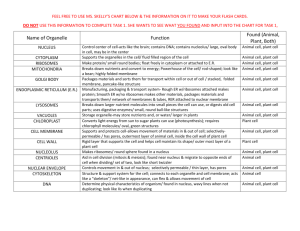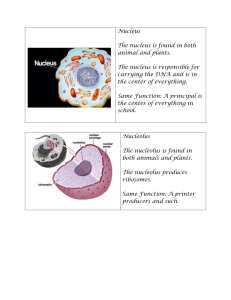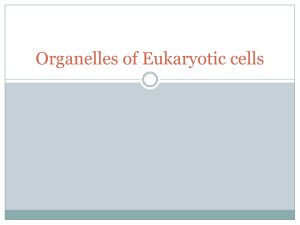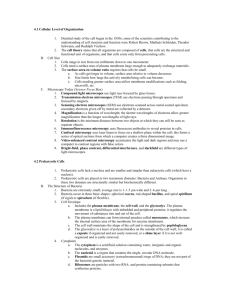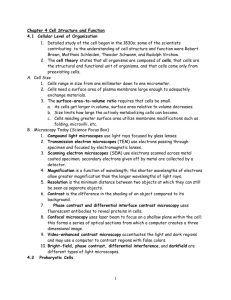Study Guide - Cloudfront.net
advertisement
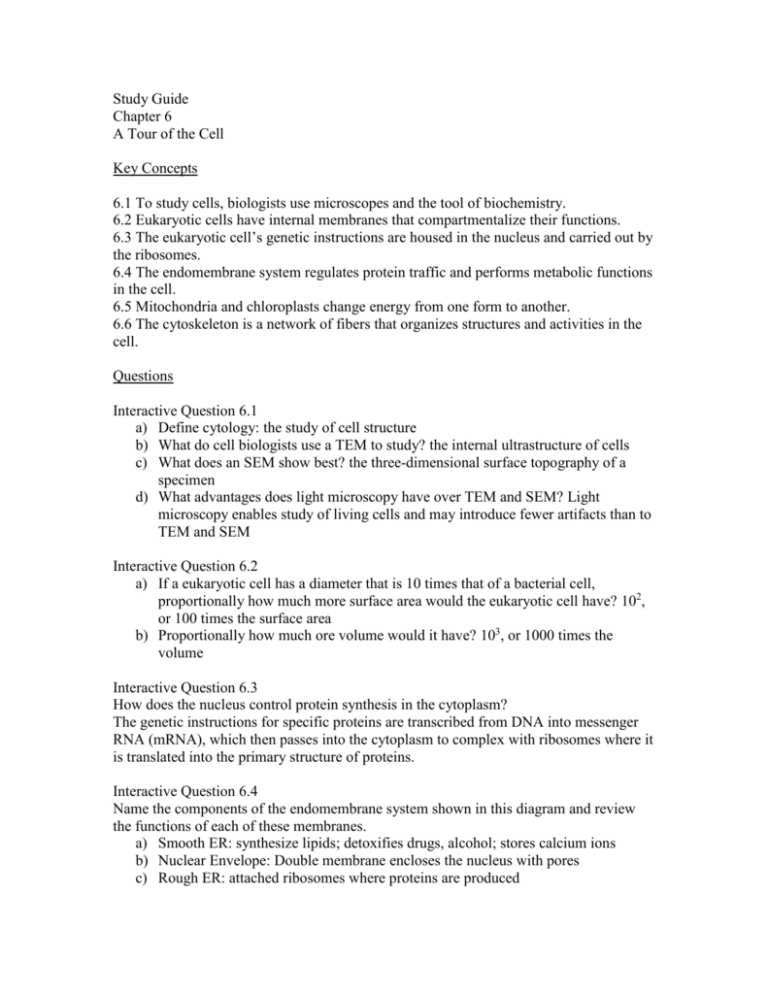
Study Guide Chapter 6 A Tour of the Cell Key Concepts 6.1 To study cells, biologists use microscopes and the tool of biochemistry. 6.2 Eukaryotic cells have internal membranes that compartmentalize their functions. 6.3 The eukaryotic cell’s genetic instructions are housed in the nucleus and carried out by the ribosomes. 6.4 The endomembrane system regulates protein traffic and performs metabolic functions in the cell. 6.5 Mitochondria and chloroplasts change energy from one form to another. 6.6 The cytoskeleton is a network of fibers that organizes structures and activities in the cell. Questions Interactive Question 6.1 a) Define cytology: the study of cell structure b) What do cell biologists use a TEM to study? the internal ultrastructure of cells c) What does an SEM show best? the three-dimensional surface topography of a specimen d) What advantages does light microscopy have over TEM and SEM? Light microscopy enables study of living cells and may introduce fewer artifacts than to TEM and SEM Interactive Question 6.2 a) If a eukaryotic cell has a diameter that is 10 times that of a bacterial cell, proportionally how much more surface area would the eukaryotic cell have? 102, or 100 times the surface area b) Proportionally how much ore volume would it have? 103, or 1000 times the volume Interactive Question 6.3 How does the nucleus control protein synthesis in the cytoplasm? The genetic instructions for specific proteins are transcribed from DNA into messenger RNA (mRNA), which then passes into the cytoplasm to complex with ribosomes where it is translated into the primary structure of proteins. Interactive Question 6.4 Name the components of the endomembrane system shown in this diagram and review the functions of each of these membranes. a) Smooth ER: synthesize lipids; detoxifies drugs, alcohol; stores calcium ions b) Nuclear Envelope: Double membrane encloses the nucleus with pores c) Rough ER: attached ribosomes where proteins are produced d) e) f) g) Transport Vesicles: carries products to various parts of the wall Golgi Apparatus: Processes products from the ER Plasma Membrane Lysosomes: Digests molecules with hydrolytic enzymes Interactive Question 6.5 Sketch a mitochondrion and a chloroplast and label their membranes and compartments. Mitochondria: Chloroplast: Interactive Question 6.6 Why are peroxisomes not considered part of the endomembrane system? They do not bud from the endomembrane system. They grow by incorporating proteins and lipids from the cytosol. They increase in number by dividing. Interactive Question 6.7 Fill in the following table to organize what you have learned about the components of the cytoskeleton. You may wish to refer to the textbook for additional details. Cytoskeleton Microtubules Structure and Monomers a. Hollow tube, formed from columns of tubulin dimers. Microfilaments (actin filaments) c. Two twisted chains of actin molecules. Intermediate filaments e. Supercoiled fibrous proteins of keratin family Functions b. Cell shape and support tracks fro moving organelles, chromosome movement, beating cilia and flagella. (25 nm diameter) d. Muscle contraction, maintain (tension bearing) and change cell shape, pseudopod movement, beating of cilia and flagella. (7 nm diameter) f. Reinforce cell shape, anchors the nucleus. (8-12 nm diameter) Interactive Question 6.8 Sketch two adjacent plant cells, and show the location of the primary and secondary cell walls and the middle lamella. Interactive Question 6.9 Return to your sketch of plant cells in Interactive Question 6.8 and draw in a plasmodesma. Structure Your Knowledge 1. The table below lists the general functions performed by an animal cell. List the cellular structures associated with each of these functions. Functions Cell Division Information storage and transferal Energy conversions Manufacture of membranes and products Lipid synthesis, drug detoxification Digestion, recycling Conversion of H2O2 to water Structural integrity Movement Exchange with environment Cell to cell connections Associated Organelles and Structures a. nucleus, chromosomes, centrioles, micro-tubules (spindle), microfilaments (actin-myosin aggregates pinch apart cell) b. nucleus, chromosome, DNA mRNA ribosomesenzymes and other proteins c. Mitochondria d. Ribosomes, rough and smooth ER, Golgi apparatus, vesicles e. smooth ER (peroxisomes also detoxify substances) f. lysosomes, food vacuoles g. peroxisomes h. cytoskeleton: microtubules, microfilaments, intermediate filaments; extracellular matrix i. cilia and flagella (microtubules), microfilaments (actin) in muscles and pseudopodia j. plasma membrane, vesicles k. desmosomes, tight and gap junctions 2. This table lists structures that are found in plant cells. Fill in the functions of these structures. Plant Cell Structures Cell Wall Central Vacuole Chloroplast Amyoplast Plasmadesmata Functions a. structural support, middle lamella glues cells together b. storage, waste disposal, protection, growth c. photosynthesis, production of carbohydrates d. starch storage e. cytoplasmic connections between cells 3. Label the indicated structures in this diagram of an animal cell. a. rough endoplasmic reticulum b. smooth endoplasmic reticulum c. chromatin d. nucleolus e. nuclear envelope f. g. h. i. j. k. l. m. n. o. p. q. r. s. nucleus ribosomes Golgi apparatus plasma membrane mitochondrion lysosome cytoskeleton microtubules intermediate filaments microfilaments microvilli peroxisomes centrosome (contains a pair of centrioles) flagellum 4. Create a diagram or flow chart in the space below to trace the development of a secretory product (such as a digestive enzyme) from the DNA code to its export from the cell. DNA (transcription of gene) mRNA (moves into cytosol and complexes with) RIBOSOME (becomes attached to) ROUGH ER (mRNA translated into polypeptide; polypeptide moves into cisternal space; may be bonded to carbohydrate to form glycoprotein) TRANSPORT VESICLES pinch off and join cis face of GOLGI APPARATUS polypeptide may be modifiedTRANSPORT VESICLES from trans face leave and fuse with PLASMA MEMBRANE Multiple Choice 1. c) mitochondria (page 98) 2. b) the sharpness or clarity of an image (page 95) 3. d) they are derived from the endoplasmic reticulum system (page 104) 4. e) all of the above (page 102) 5. a) transmission electron microscopy (page 96) 6. d) lysosome—food sac formed by phagocytosis (page 107) 7. a) protein (page 112) 8. c) taking up water into its central vacuole (page 108) 9. b) secondary cell wall (page 118) 10. d) actin filaments (page 116) 11. e) the pinching apart of the cytoplasm in animal cell division (page 114) 12. b) rough ERtransport vesiclesGolgivesiclesplasma membrane (page 104) 13. b) by free ribosomes (page 98) 14. c) gap junctions (page 120) 15. e) nuclei (page 97) 16. d) epithelial cell lining digestive tract (page 120) 17. c) macrophage (white blood cell) that engulfs bacteria (page 107) 18. e) ovarian cell that produces estrogen (a steroid hormone) (page 104) 19. b) pancreatic cell that manufactures digestive enzymes (page 102) 20. a) muscle cell in the thigh muscle of a long-distance runner (page 109) Fill in the Blanks 1) 2) 3) 4) transports membranes and products to various locations: transport vesicle infoldings of the inner mitochondrial membrane with attached enzymes: cristae consists of collagen, proteoglycans, and fibronectins: ECM specialized metabolic compartments with enzymes that transfer hydrogen to oxygen, producing H2O2: peroxisomes 5) stacks of flattened sacs inside chloroplasts: grana 6) anchoring structure for cilia and flagella: basal body 7) semifluid medium between nucleus and plasma membrane: cytosol 8) system of fibers that maintains cell shape, anchors organelles: cytoskeleton 9) connection between animal cells that creates impermeable layer: tight junction 10) membrane surrounding central vacuole of plant cells: tonoplast


